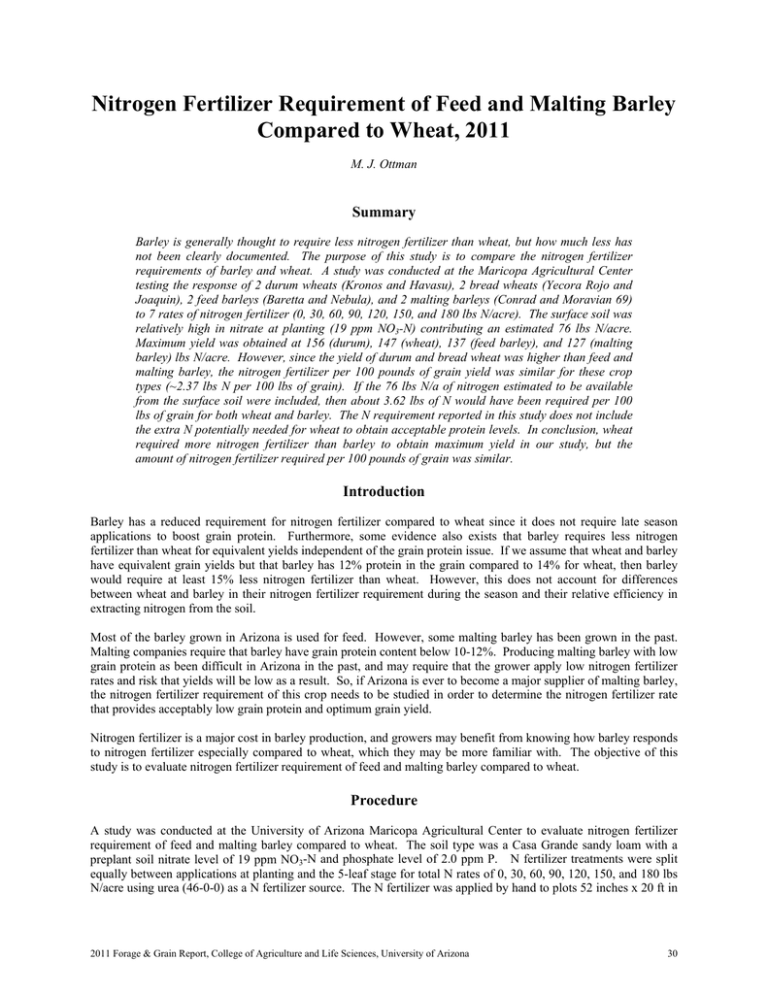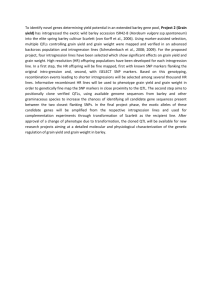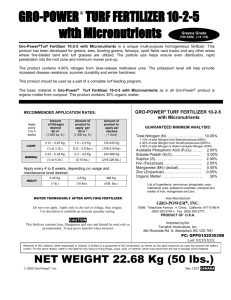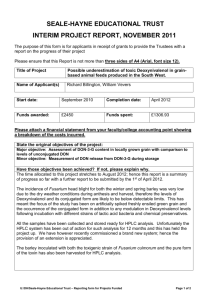Nitrogen Fertilizer Requirement of Feed and Malting Barley Summary
advertisement

Nitrogen Fertilizer Requirement of Feed and Malting Barley Compared to Wheat, 2011 M. J. Ottman Summary Barley is generally thought to require less nitrogen fertilizer than wheat, but how much less has not been clearly documented. The purpose of this study is to compare the nitrogen fertilizer requirements of barley and wheat. A study was conducted at the Maricopa Agricultural Center testing the response of 2 durum wheats (Kronos and Havasu), 2 bread wheats (Yecora Rojo and Joaquin), 2 feed barleys (Baretta and Nebula), and 2 malting barleys (Conrad and Moravian 69) to 7 rates of nitrogen fertilizer (0, 30, 60, 90, 120, 150, and 180 lbs N/acre). The surface soil was relatively high in nitrate at planting (19 ppm NO3-N) contributing an estimated 76 lbs N/acre. Maximum yield was obtained at 156 (durum), 147 (wheat), 137 (feed barley), and 127 (malting barley) lbs N/acre. However, since the yield of durum and bread wheat was higher than feed and malting barley, the nitrogen fertilizer per 100 pounds of grain yield was similar for these crop types (~2.37 lbs N per 100 lbs of grain). If the 76 lbs N/a of nitrogen estimated to be available from the surface soil were included, then about 3.62 lbs of N would have been required per 100 lbs of grain for both wheat and barley. The N requirement reported in this study does not include the extra N potentially needed for wheat to obtain acceptable protein levels. In conclusion, wheat required more nitrogen fertilizer than barley to obtain maximum yield in our study, but the amount of nitrogen fertilizer required per 100 pounds of grain was similar. Introduction Barley has a reduced requirement for nitrogen fertilizer compared to wheat since it does not require late season applications to boost grain protein. Furthermore, some evidence also exists that barley requires less nitrogen fertilizer than wheat for equivalent yields independent of the grain protein issue. If we assume that wheat and barley have equivalent grain yields but that barley has 12% protein in the grain compared to 14% for wheat, then barley would require at least 15% less nitrogen fertilizer than wheat. However, this does not account for differences between wheat and barley in their nitrogen fertilizer requirement during the season and their relative efficiency in extracting nitrogen from the soil. Most of the barley grown in Arizona is used for feed. However, some malting barley has been grown in the past. Malting companies require that barley have grain protein content below 10-12%. Producing malting barley with low grain protein as been difficult in Arizona in the past, and may require that the grower apply low nitrogen fertilizer rates and risk that yields will be low as a result. So, if Arizona is ever to become a major supplier of malting barley, the nitrogen fertilizer requirement of this crop needs to be studied in order to determine the nitrogen fertilizer rate that provides acceptably low grain protein and optimum grain yield. Nitrogen fertilizer is a major cost in barley production, and growers may benefit from knowing how barley responds to nitrogen fertilizer especially compared to wheat, which they may be more familiar with. The objective of this study is to evaluate nitrogen fertilizer requirement of feed and malting barley compared to wheat. Procedure A study was conducted at the University of Arizona Maricopa Agricultural Center to evaluate nitrogen fertilizer requirement of feed and malting barley compared to wheat. The soil type was a Casa Grande sandy loam with a preplant soil nitrate level of 19 ppm NO3-N and phosphate level of 2.0 ppm P. N fertilizer treatments were split equally between applications at planting and the 5-leaf stage for total N rates of 0, 30, 60, 90, 120, 150, and 180 lbs N/acre using urea (46-0-0) as a N fertilizer source. The N fertilizer was applied by hand to plots 52 inches x 20 ft in 2011 Forage & Grain Report, College of Agriculture and Life Sciences, University of Arizona 30 size. The seed was planted with a cone planter in seven rows spaced 6 inches apart and 20 ft long. The seeding rate was approximately 100 lbs/acre for durum varieties and 85 lbs/acre for barley varieties. The experimental design of was a split plot with N rates (0, 30, 60, 90, 120, 150, and 180 lbs N/acre) as main plots and varieties (Kronos and Havasu durums, Yecora rojo and Jaoquin wheat, Baretta and Nebula feed barley, and Conrad and Moravian 69 malting barley) as subplots, and replicated 4 times. Cultural practices are listed in Table 1. The following data was collected: grain yield, straw yield, total yield, harvest index, test weight, plant height, lodging, heading, physiological maturity, yellow berry, grain protein, straw N concentration and light interception on Feb 10 at the 5 leaf stage. Grain was harvested with a small plot combine and yields are expressed on an “as is” moisture basis. HVAC was determined from 10 g of seed. Physiological maturity is defined as when the glumes turn brown. Light interception was determined by dividing the average of six readings from a sunfleck ceptometer at ground level by incident light level. Grain protein was expressed on a 12% moisture basis and straw N was expressed on a 0% moisture basis. Abbreviations for the sources of varieties are: APB = Arizona Plant Breeders, WPB = Western Plant Breeders, WWW = World Wide Wheat, UC = University of California. Results and Discussion This growing season was characterized by below average temperature overall and below average rainfall (Table 2). Even though the overall temperature was average, February and May were colder than average and December was warmer than average. Unusually cold weather during February in particular slowed the crop growth and could have caused unseen damage, although the only damage evident was some leaf tip burn. Grain yield increased with nitrogen fertilizer application for all the varieties tested (Table 3). The yield increase could be described by a linear and/or quadratic function. Plant height of Kronos, Yecora Rojo, and Conrad was increased by N rate. Light interception of Kronos was increased by N rate. Heading of Conrad, maturity of Baretta, and maturity averaged over varieties was delayed by N rate. Harvest index, test weight, lodging, yellow berry, grain protein, and straw N were not affected by N rate. Differences among varieties were detected for all variables measured. The only variety x N rate interaction detected was for lodging. Maximum yield was obtained at 156 (durum), 147 (wheat), 137 (feed barley), and 127 (malting barley) lbs N/acre, However, since the yield of durum and bread wheat was higher than feed and malting barley, the nitrogen fertilizer per 100 pounds of grain yield was similar for these crop types (~2.37 lbs N per 100 lbs of grain). If the 76 lbs N/a of nitrogen estimated to be available from the surface soil were included, then about 3.62 lbs of N would have been required per 100 lbs of grain for both wheat and barley. The N requirement reported in this study does not include the extra N potentially needed for wheat to obtain acceptable protein levels. It is worth noting that the differences among varieties with crop types were large. In conclusion, wheat required more nitrogen fertilizer than barley to obtain maximum yield in our study, but the amount of nitrogen fertilizer required per 100 pounds of grain was similar. Acknowledgments Financial support for this project was received from the Arizona Grain Research and Promotion Council and the Arizona Crop Improvement Association. The technical assistance of Richard and Glenda Simer and Mary Comeau is greatly appreciated. 2011 Forage & Grain Report, College of Agriculture and Life Sciences, University of Arizona 31 Table 1. Cultural practices for the small grain nitrogen trial at Maricopa. Cultural information Maricopa Previous crop Fallow Soil texture Sandy Loam Nominal planting date 12/14/10 Effective planting date 12/15/10 Irrigation dates (amount) 12/15 (3.21 in.) 1/27 (3.89 in.) 2/25 (3.59 in.) 3/17 (3.89 in.) 3/31 (2.39 in.) 4/13 (5.38 in.) 4/25 (4.08 in.) Total (26.43 in.) Nitrogen dates (amount) 12/15 (0 to 90 lbs N/a) as 46-0-0 1/27 (0 to 90 lbs N/a) as 46-0-0 Total = 0 to 180 lbs N/a Phosphorus (date, amount, fertilizer) 12/15 (50 lbs P2O5/a) 0-45-0 Pesticides (date) None Harvest date 5/26 Table 2. Climatic data from AZMET for Maricopa during the 2011 growing season compared to the long-term average. Climate variable Unit Year(s) Dec Jan Feb Mar Apr May Dec-May Max Temp. ºF ºF 2011 Avg 70 65 67 66 66 70 79 77 85 85 90 95 76 76 Min Temp. ºF ºF 2011 Avg 38 35 32 36 34 39 44 44 54 51 57 60 43 44 Ppt. inches inches 2011 Avg 0.39 0.62 0 0.72 0.4 0.85 0.05 0.79 0.32 0.26 0 0.2 1.16 3.43 2011 Forage & Grain Report, College of Agriculture and Life Sciences, University of Arizona 32 Table 3. Response of small grain varieties to nitrogen rate at Maricopa in 2011. Crop types planted were durum (Kronos and Havasu), wheat (Yecora Rojo and Joaquin), feed barley (Baretta and Nebula), and malting barley (Conrad and Moravian 69). The surface soil was relatively high in nitrate at planting time (19 ppm NO3-N). Variety N rate Grain Harvest Test yield Index weight Light Plant intercep- Head- Matur- Yellow Grain Straw height Lodging tion ing ity berry protein N lbs N/a lbs/a % lbs/bu inches % % 0 5869 46.1 61.5 33.3 0 52 3/24 30 6091 48.9 60.8 33.8 6 48 60 6365 47.8 61.1 34.3 6 90 6404 50.5 61.9 33.8 120 6656 48.8 61.8 150 6698 49.3 180 6812 linear % % % 5/3 6 13.6 0.39 3/24 5/2 4 13.3 0.34 40 3/24 5/3 3 14.2 0.32 0 59 3/25 5/3 3 13.9 0.40 34.0 0 69 3/25 5/2 1 14.3 0.40 61.5 34.5 25 60 3/25 5/4 1 13.8 0.46 47.5 62.3 35.5 0 71 3/25 5/4 5 13.4 0.41 * ns ns * ns * ns ns ns ns ns quadratic ns ns ns ns ns ns ns ns ns * ns 0 4603 42.5 63.0 33.5 0 76 3/26 5/4 1 14.6 0.37 30 5809 46.7 63.2 34.8 0 74 3/26 5/3 7 13.2 0.32 60 5997 45.9 62.7 33.8 0 50 3/25 5/2 3 14.4 0.47 90 6414 42.5 62.6 35.8 6 73 3/25 5/3 3 13.5 0.38 120 6638 42.8 62.9 34.0 0 67 3/25 5/4 1 14.7 0.45 150 7099 46.6 63.0 35.3 0 41 3/27 5/4 0 14.2 0.39 180 6691 44.0 62.5 35.3 0 61 3/26 5/4 0 14.3 0.43 linear * ns ns ns ns ns ns ns ns ns ns quadratic ns ns ns ns ns ns ns ns ns ns ns Yecora 0 4094 48.6 62.3 28.5 0 74 3/27 5/1 2 14.5 0.39 rojo 30 4259 46.7 62.6 29.3 0 53 3/28 5/3 11 13.5 0.32 60 4778 47.2 62.7 30.5 0 58 3/28 5/3 1 14.3 0.44 90 5338 46.5 62.0 31.3 0 61 3/30 5/4 4 13.8 0.41 120 5870 47.8 62.3 30.3 0 67 3/30 5/4 0 15.1 0.44 150 5791 47.6 62.4 30.5 0 48 3/29 5/4 0 14.8 0.49 180 6260 47.5 63.1 29.0 0 63 3/27 5/3 1 14.7 0.38 linear ** ns ns ns ns ns ns ns ns ns ns quadratic ns ns ns * ns ns ns ns ns ns ns 0 4675 45.1 62.4 35.3 0 70 3/26 5/4 0 15.9 0.51 30 4830 45.5 62.7 35.5 0 45 3/27 5/3 11 13.9 0.33 60 5252 43.9 62.5 35.5 0 49 3/26 5/3 4 14.3 0.38 Kronos Havasu Joaquin 2011 Forage & Grain Report, College of Agriculture and Life Sciences, University of Arizona 33 Baretta Nebula Conrad Moravian 69 90 6039 45.8 61.9 37.0 0 72 3/27 5/4 1 14.3 0.32 120 5370 44.4 61.9 35.3 0 65 3/27 5/3 0 16.0 0.57 150 5410 44.7 62.8 33.3 0 55 3/25 5/4 0 15.3 0.43 180 5022 45.4 62.6 36.3 0 57 3/27 5/3 2 15.3 0.41 linear ns ns ns ns ns ns ns ns ns ns ns quadratic ** ns ns ns ns ns ns ns ns ns ns 0 5083 50.5 50.8 28.8 0 55 3/28 5/1 ---- 12.6 0.67 30 5256 52.0 51.0 29.0 0 52 3/30 5/2 ---- 12.2 0.65 60 5515 50.7 51.2 29.0 0 60 3/26 5/1 ---- 12.5 0.58 90 6373 50.5 51.3 28.3 0 39 3/28 5/2 ---- 12.5 0.66 120 5953 51.2 51.2 28.5 0 27 3/29 5/3 ---- 12.8 0.68 150 6361 50.9 50.6 30.5 0 36 3/28 5/4 ---- 12.5 0.73 180 5830 51.7 50.7 29.8 0 33 3/28 5/3 ---- 11.8 0.56 linear ** ns ns ns ns ns ns * ---- ns ns quadratic ns ns ns ns ns ns ns ns ---- ns ns 0 3575 37.7 52.0 30.3 0 32 3/25 4/28 ---- 13.0 0.68 30 3857 35.4 51.2 31.2 0 50 3/25 4/29 ---- 12.1 0.75 60 4225 41.8 51.3 32.3 0 52 3/25 5/1 ---- 12.9 0.69 90 4388 39.3 51.7 32.3 0 42 3/25 5/1 ---- 12.2 0.89 120 4956 39.3 49.6 30.3 0 36 3/25 5/1 ---- 12.8 0.79 150 4970 37.7 48.5 32.0 0 55 3/25 5/1 ---- 13.2 0.89 180 4503 35.1 51.4 32.0 0 59 3/24 5/1 ---- 13.0 0.77 linear * ns ns ns ns ns ns ns ---- ns ns quadratic ns ns ns ns ns ns ns ns ---- ns ns 0 3676 34.7 52.7 37.3 0 67 3/19 4/22 ---- 13.8 0.51 30 4259 39.6 54.5 35.3 0 70 3/20 4/23 ---- 13.0 0.46 60 4074 41.4 53.8 37.5 0 59 3/19 4/24 ---- 12.8 0.49 90 4954 35.4 54.3 38.8 0 81 3/19 4/22 ---- 12.8 0.43 120 5325 39.7 54.1 38.3 0 78 3/20 4/25 ---- 14.7 0.52 150 4582 35.6 53.5 40.0 6 67 3/22 4/23 ---- 14.0 0.66 180 4426 38.3 54.2 39.3 0 76 3/22 4/23 ---- 14.1 0.59 linear * ns ns * ns ns * ns ---- ns ns quadratic * ns ns ns ns ns ns ns ---- ns ns 0 30 60 90 3985 5124 5482 5820 44.2 42.7 45.7 45.0 52.6 52.1 51.9 52.7 31.6 32.8 32.3 31.8 0 0 0 0 50 60 49 49 4/1 4/3 4/3 4/3 5/1 5/1 5/1 5/1 ------------- 11.8 11.5 11.9 11.3 0.54 0.51 0.66 0.63 2011 Forage & Grain Report, College of Agriculture and Life Sciences, University of Arizona 34 Avg 120 5775 150 5985 180 4861 linear ns quadratic ** 43.4 40.4 41.8 ns ns 52.4 52.3 51.7 ns ns 31.8 32.3 31.5 ns ns 0 0 0 ns ns 70 54 47 ns ns 4/3 4/3 4/3 ns ns 5/1 5/1 5/1 ns ns ---------------- 12.3 12.1 11.9 ns ns 0.56 0.57 0.64 ns ns 0 30 60 90 120 150 180 linear quadratic 4445 4936 5211 5716 5818 5862 5551 ** ** 43.7 44.7 45.6 44.4 44.7 44.1 43.9 ns ns 57.2 57.3 57.1 57.3 57.0 56.8 57.3 ns ns 32.3 32.7 33.1 33.6 32.8 33.5 33.6 ns ns 0 1 1 1 0 4 0 ns ns 60 56 52 59 60 52 59 ns ns 3/26 3/26 3/26 3/26 3/27 3/27 3/26 ns ns 4/30 5/1 5/1 5/1 5/1 5/2 5/1 * ns 2 8 3 3 1 0 2 ns ns 13.7 12.9 13.4 13.0 14.1 13.8 13.5 ns ns 0.51 0.46 0.50 0.51 0.55 0.58 0.52 ns ns 6414 6179 5199 5228 5767 4354 4471 5290 522 48.4 44.4 47.4 45.0 51.1 38.0 37.8 43.3 1.8 61.6 62.8 62.5 62.4 51.0 50.8 53.9 52.2 0.5 34.1 34.6 29.9 35.4 29.1 31.5 38.0 32.0 0.9 5 1 0 0 0 0 1 0 2 57 63 61 59 43 47 71 54 11 3/24 3/26 3/28 3/26 3/28 3/25 3/20 4/2 1 5/3 5/3 5/3 5/3 5/2 4/30 4/23 5/1 1 3 2 3 3 ------------ns 13.8 14.1 14.4 15.0 12.4 12.7 13.6 11.8 0.4 0.39 0.40 0.41 0.42 0.65 0.78 0.52 0.59 0.07 ns ns ns ns ns ns ns ns ns ns ns Kronos Avg Havasu Y. Rojo Joaquin Baretta Nebula Conrad Moravian 69 LSD.05 Variety x N rate 2011 Forage & Grain Report, College of Agriculture and Life Sciences, University of Arizona 35 Table 4. Regression analysis of grain yield vs. N rate for small grain varieties using the equation y=a+bx2+cx3. Crop Type Variety Coef. of determination (r2) Wheat Durum Kronos Havasu Y. Rojo Joaquin Baretta Nebula Conrad Moravian 69 Bread wheat Barley Feed Malting Maximum N rate lbs N/a Maximum yield lbs/a N rate/ 100 lb yield lbs N/ 100 lbs grain 0.94 0.85 0.97 0.66 0.83 0.97 0.76 0.80 166 146 170 123 135 139 128 125 6793 7029 6163 5696 6321 4950 5070 6089 2.44 2.08 2.76 2.16 2.14 2.81 2.52 2.05 --------- Durum Bread wheat Feed barley Malting barley --------- --------- 156 147 137 127 6911 5930 5636 5580 2.26 2.46 2.47 2.29 Wheat Barley ----- ----- ----- 151 132 6420 5608 2.36 2.38 2011 Forage & Grain Report, College of Agriculture and Life Sciences, University of Arizona 36






